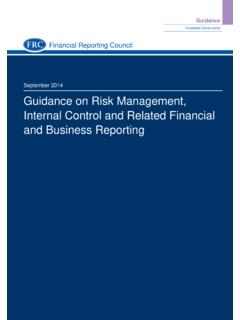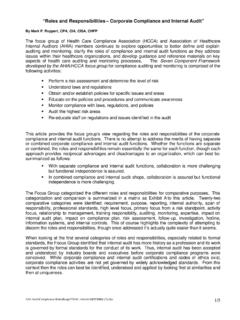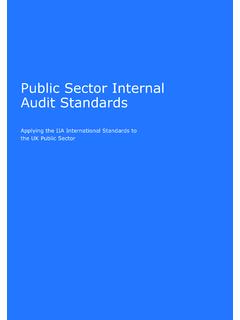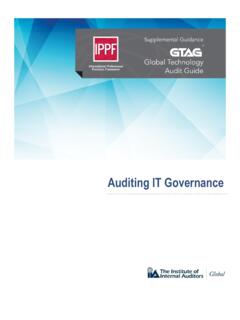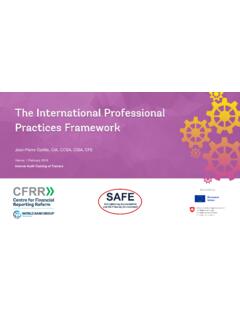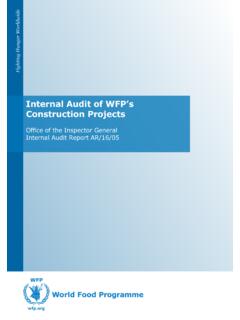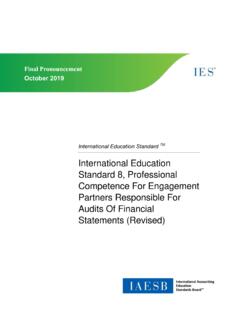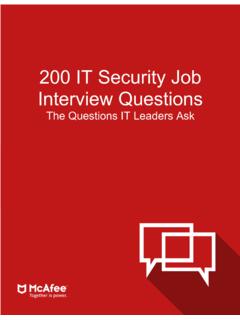Transcription of HOW TO RESPOND TO A L - Jackson Walker
1 HOW TO RESPOND TO AUDIT LETTERS. By BYRON F. EGAN JAMES D. GOLDSMITH CHARLES R. LOTTER. Jackson Walker Associate General Counsel Former Executive Vice 901 Main Street, Suite 6000 KPMG LLP President, Secretary and Dallas, Texas 75202-3797 757 Third Ave, 11 Floor General Counsel New York, New York 10017 Penney Corp., Inc. 6501 Legacy Drive Plano, TX 75024. STATE BAR OF TEXAS CLE TELEPHONE SEMINAR. JULY 29, 2005. Copyright 2005 by Byron F. Egan, James D. Goldsmith and Charles R. Lotter. All rights reserved. TABLE OF CONTENTS. I. PRESSURE ON AUDITORS TO DETECT corporate Section SEC Enforcement Actions ..7. PCAOB ..9. II. MISLEADING STATEMENTS TO AUDITORS ..10. III. ENHANCED ATTORNEY RESPONSIBILITIES UNDER SOX ..15. SOX Relationship to State Disciplinary Rules ..16. Attorneys Covered ..17. Who is the Client?..17. What Evidence Triggers Reporting Duty?..18. Duty to Report Evidence of a Material Alternative Reporting Procedures For An Issuer That Has Established A QLCC ..22. Issuer Confidences.
2 22. Responsibilities of Supervisory Responsibilities of a Subordinate Attorney ..24. Sanctions and No SOX 307 Private Right of Action ..24. No SOX 307 Private Right of Action ..24. Enron Civil Liability Attorney-Client/Work Product Privilege ..26. Differences From Proposed Rules ..27. IV. ATTORNEY-CLIENT PRIVILEGE AND THE WORK PRODUCT DOCTRINE IN. THE corporate CONTEXT ..28. Attorney-Client Derivative Actions ..29. Legal Advice Purpose ..31. Internal Generally Unprivileged No Waiver Where Common Interest ..35. Issue Injection ..37. Scope of Exceptions to the Privilege ..44. Work Product Doctrine ..45. Legal Fee Audits ..49. Mergers and Acquisitions ..49. V. ATTORNEY LETTERS TO AUDITORS ..52. i SFAS 5 ..52. SAS 12 ..52. ABA Statement ..54. Discoverability of Audit Response Letters ..59. VI. SELECTED RESPONSE LETTER ISSUES ..66. Is the ABA Statement Superseded by SOX 303? ..66. The Company Law Firm Policies ..68. Estimates of Loss ..68. Requests Beyond Scope of ABA Statement ..69. Requests for Updates or Informal Information as to Specific VII.
3 EXHIBIT A SUMMARY OF SOX. EXHIBIT B FORM OF LAW FIRM RESPONSE LETTER. ii HOW TO RESPOND TO AUDIT LETTERS. By Byron F. Egan, Dallas, TX. James D. Goldsmith, New York, NY. Charles R. Lotter, Dallas, TX*. A grand compromise or treaty was reached in 1976 between the lawyers and the accountants that is reflected in the ABA Statement of Policy regarding Lawyers' Responses to Auditors' Requests for Information (the ABA Statement ).1 The ABA Statement is intended to facilitate lawyers' provision of information to auditors regarding client loss contingencies in connection with the preparation and examination of client financial statements, while minimizing the risk of loss of attorney-client privilege in the process. Auditors rely upon the letters provided by their clients' counsel regarding loss contingencies ( Response Letters ) as they examine and report upon client financial statements. This gives the Response Letters a significant role in financial disclosure processes. Malpractice and other claims against attorneys can result from Response Letters and other statements to auditors regarding loss contingencies, particularly when a prediction is made regarding the likelihood of an unfavorable outcome or the amount or range of loss in the event of an unfavorable outcome.
4 The importance of the ABA Statement and the need for attorney diligence in preparing Response Letters and communicating with auditors were magnified when on July 30, 2002. President Bush signed the Sarbanes-Oxley Act of 2002 ( 3763) ( SOX ).2 This is the *. Copyright 2005 by Byron F. Egan, James D. Goldsmith and Charles R. Lotter. All rights reserved. Byron F. Egan is a partner of Jackson Walker in Dallas, Texas. Mr. Egan is a former Chairman of the Texas Business Law Foundation and is also former Chairman of the Business Law Section of the State Bar of Texas and of that Section's Corporation Law Committee. Mr. Egan is Vice-Chair of the ABA Business Law Section's Negotiated Acquisitions Committee and former Co-Chair of its Asset Acquisition Agreement Task Force, which published the ABA Model Asset Purchase Agreement with Commentary (2001). He is also a member of the American Law Institute. James D. Goldsmith is Associate General Counsel of KPMG LLP in New York, New York. Charles R.
5 Lotter is the former Executive Vice President, Secretary & General Counsel of, and is now a consultant to, Penney Corp., Inc. in Plano, Texas. The authors wish to acknowledge the contributions of the following in preparing this paper: Cullen M. Godfrey, A. Scott Goldberg and Sabrina A. McTopy of Jackson Walker in Austin, Dallas and Houston, Texas. 1. 31 Bus. Law. 5 (April 1976), reprinted in ABA AUDITOR'S LETTER HANDBOOK (2003). 2. A summary of SOX is attached as Exhibit A. See Byron F. Egan, The Sarbanes-Oxley Act and Its Expanding Reach, 40 Tex. J. of Bus. L. 305 (Winter 2005). 1. tough new corporate fraud bill trumpeted by the politicians and in the media as a response to the corporate scandals of 2001-2002 and as a means to protect investors by improving the accuracy and reliability of corporate disclosures made pursuant to the securities laws. Among other things, SOX amends the Securities Exchange Act of 1934 (the 1934 Act ) and the Securities Act of 1933 (the 1933 Act ). Although SOX does have some specific provisions, and generally establishes some important public policy changes, it is being implemented in large part through rules adopted and to be adopted by the Securities and Exchange Commission ( SEC ) and the Public Company Accounting Oversight Board ( PCAOB ), which have impacted auditing standards and have increased scrutiny on auditors' procedures to verify company positions and representations.
6 Further, while SOX is by its terms generally applicable only to public companies,3 its principles are being applied to privately held companies4 and nonprofit 3. SOX is generally applicable to all companies required to file reports with the SEC under the 1934 Act ( reporting companies ) or that have a registration statement on file with the SEC under the 1933 Act, in each case regardless of size (collectively, public companies or issuers ). Some of the SOX provisions apply only to companies listed on a national securities exchange ( listed companies ), such as the New York Stock Exchange ( NYSE ) or the NASDAQ Stock Market ( NASDAQ ) (the national securities exchanges and NASDAQ are referred to collectively as SROs ), but not to companies traded on the NASD OTC Bulletin Board or quoted in the Pink Sheets or the Yellow Sheets. Small business issuers that file reports on Form 10-QSB and Form 10-KSB are subject to SOX generally in the same ways as larger companies although some specifics vary (references herein to Forms 10-Q and 10-K include Forms 10- QSB and 10-KSB).
7 SOX and the SEC's rules thereunder are applicable in many, but not all, respects to (i) investment companies registered under the Investment Company Act of 1940 (the 1940 Act ) and (ii) public companies domiciled outside of the United States of America (the ) ( foreign companies ). Companies that file periodic reports with the SEC solely to comply with covenants under debt instruments, to facilitate sales of securities under Rule 144 or for other corporate purposes ( voluntary filers ), rather than pursuant to statutory or regulatory requirements to make such filings, are not issuers and generally are not required to comply with most of the corporate governance provisions of SOX. The SEC's rules and forms implementing SOX that require disclosure in periodic reports filed with the SEC apply to voluntary filers by virtue of the fact that voluntary filers are contractually required to file periodic reports in the form prescribed by the rules and regulations of the SEC. The SEC appears to be making a distinction in its rules between governance requirements under the Act (which tend to apply only to statutory issuers ) and disclosure requirements (which tend to apply to all companies filing reports under the 1934 Act).
8 While SOX is generally applicable only to public companies, there are three important exceptions: (i) SOX. 802 and 1102 make it a crime for any person to alter, destroy, mutilate or conceal a record or document so as to (x) impede, obstruct or influence an investigation or (y) impair the object's integrity or availability for use in an official proceeding; (ii) SOX 1107 makes it a crime to knowingly, with the intent to retaliate, take any action harmful to a person for providing to a law enforcement officer truthful information relating to the commission of any federal offense; and (iii) SOX 904 raises the criminal monetary penalties for violation of the reporting and disclosure requirements of the Employee Retirement Income Security Act of 1974 ( ERISA ). These three provisions are applicable to private and nonprofit entities as well as public companies. 4. Private companies that contemplate going public, seeking financing from investors whose exit strategy is a public offering or being acquired by a public company may find it advantageous or necessary to conduct their affairs as if they were subject to SOX.
9 See Joseph Kubarek, Sarbanes-Oxley Raises the Bar for Private Companies, NACD-Directors Monthly (June 2004 at 19-20); Peter H. Ehrenberg and Anthony O. 2. Following the enactment of SOX and the adoption of rules thereunder, the role of independent auditors in detecting financial statement fraud within public companies has received enhanced scrutiny. In turn, companies are expected both to implement controls for dealing with alleged fraud internally and to provide their auditors with detailed information on a wide range of corporate issues. Companies involve legal counsel, both in-house and outside, for a wide variety of tasks, from conducting investigations of alleged fraud to dealing with employee issues (including whistleblower complaints) and advising directors on their duties in connection with corporate transactions. Auditors are increasingly asking for information regarding these often privileged communications to supplement their reliance on management representations. Making such privileged information available to auditors, however, subjects companies to the risk of loss of attorney client and work product privileges, which can provide a road-map to success for adversaries in civil litigation.
10 SOX does not repudiate the ABA Statement. SOX does, however, reinforce the importance of providing meaningful information to auditors. Further SOX mandates that attorneys not mislead or improperly influence auditors in the performance of an audit as that could result in misleading financial statements. While not denying the right of lawyers to rely on the ABA Statement in actions taken in conformity with the ABA Statement, SEC rulemaking and enforcement actions post-SOX. attempt to place lawyers in the role of gatekeepers or sentries of the marketplace whose responsibilities include ensuring that our markets are clean. 6 These SEC actions do, however, affect the role of the lawyer in dealing with clients, auditors and I. PRESSURE ON AUDITORS TO DETECT corporate FRAUD. GAAS. Generally acceptable auditing standards ( GAAS ) recognize that auditors have particular responsibilities with respect to the discovery of corporate fraud during an audit. The auditor has a responsibility to plan and to perform financial statement audits in order to obtain Pergola, Why Private Companies Should Not Ignore the Sarbanes-Oxley Act, Wall Street Lawyer (December 2002 at 12-13).

